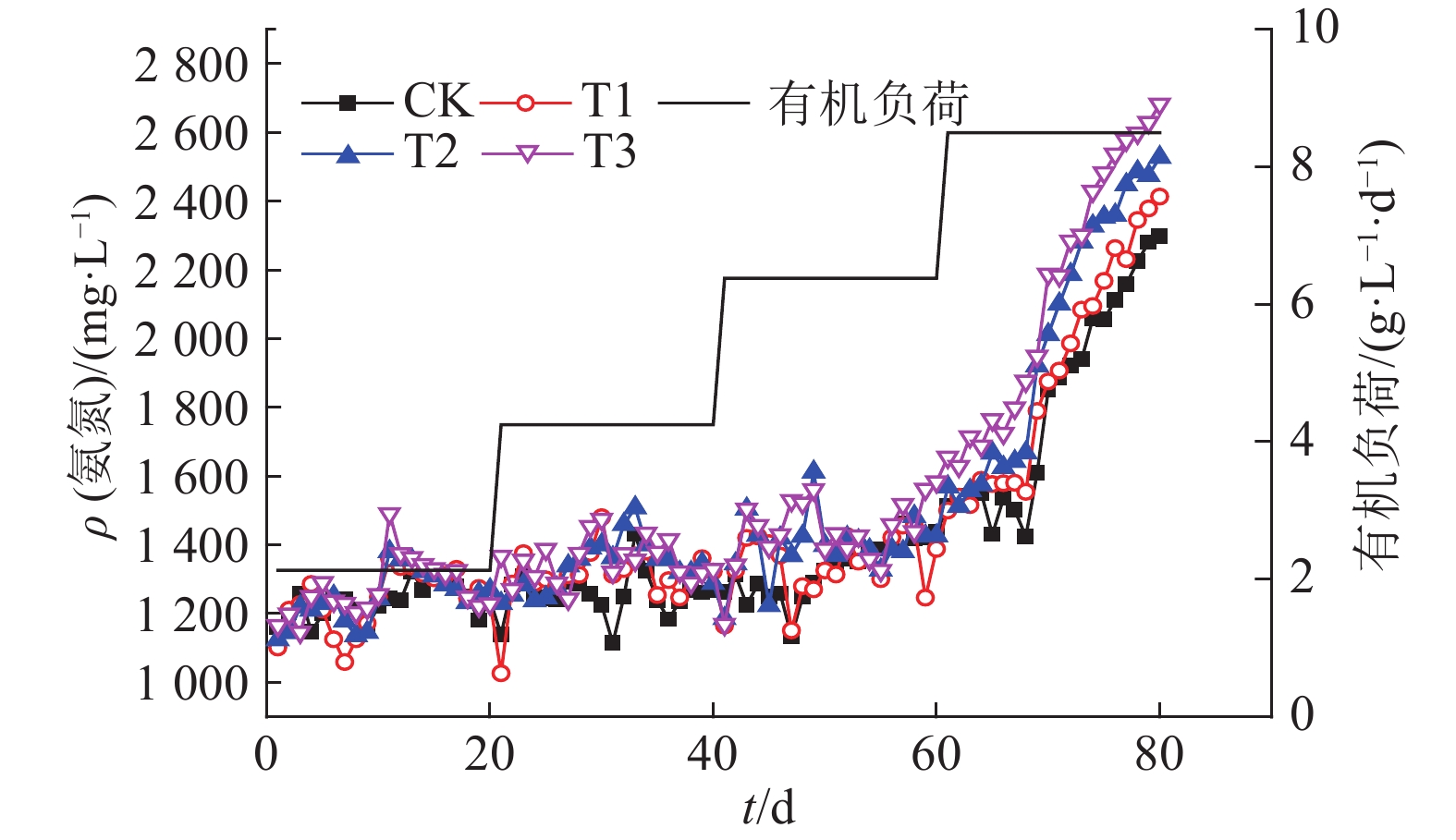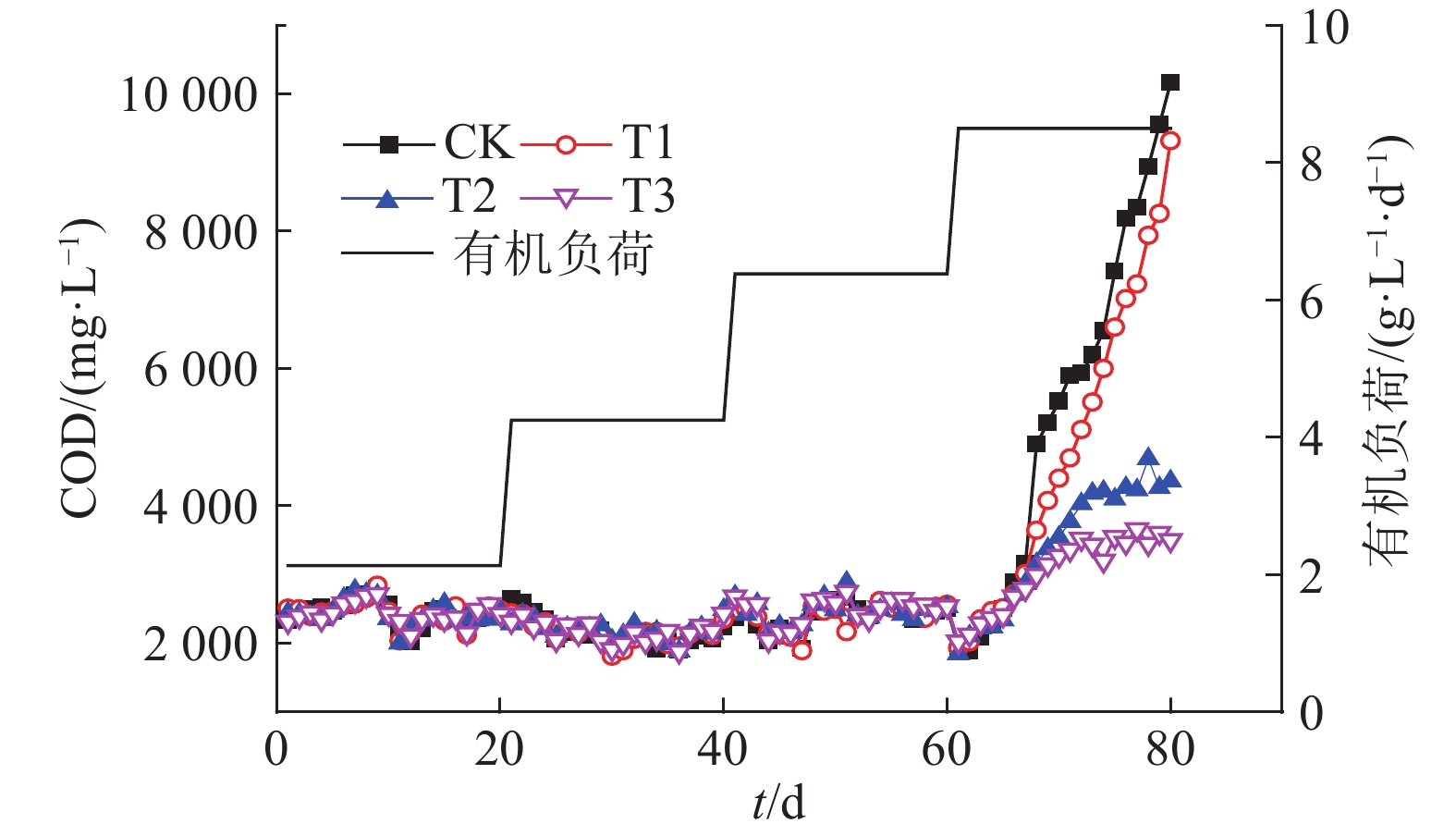Effects of organic loading rate and reflux ratio on two-phase anaerobic digestion of food waste
-
摘要:目的
研究产甲烷相的有机负荷与沼液的不同回流比在餐厨垃圾两相厌氧消化过程中对产酸和产气的影响。
方法以餐厨垃圾为原料,采用两相厌氧消化工艺,分别设置了不同的有机负荷与回流比,考察两者对两相厌氧消化产酸和产气的影响。
结果沼液回流可以提高产酸相的pH,促进餐厨垃圾酸化,在产酸相有机负荷(以挥发性固体物含量计,下同)为11.33 g·L–1·d–1时,回流比为10%、30%和50%处理的挥发性脂肪酸(VFA)质量浓度分别为11 598.48、12 998.41和14 967.64 mg·L–1,比空白处理(CK)分别提高了9.06%、22.23%和40.74%;在沼液不回流时,产甲烷相的最适有机负荷为6.38 g·L–1·d–1,当负荷提高至8.50 g·L–1·d–1时,系统出现了酸抑制现象,而回流比为50%时,可以提高系统的缓冲性,维持系统的稳定;回流比50%处理的平均负荷产气量(以挥发性固体物含量计)为486.14 mL·g–1,比CK、回流比10%和30%处理分别提高了29.84%、20.80%和9.13%。
结论餐厨垃圾两相厌氧消化过程中,沼液不回流时,产甲烷相的最适有机负荷为6.38 g·L–1·d–1;继续提高有机负荷,系统会产生酸抑制现象;当沼液回流比为50%时,产甲烷相的最适有机负荷可以提高至8.50 g·L–1·d–1,系统可以保持稳定运行。
Abstract:ObjectiveTo examine the effects of different organic loading rate (OLR) and effluent recirculation rate on acid and gas productions during the two-phase anaerobic digestion of food waste.
MethodThe effects of acid and gas productions of the two-phase anaerobic digestion of food waste were investigated by setting different organic loading rate and reflux ratio.
ResultEffluent recirculation significantly increased the pH of acidogenic reactor and accelerated the acidification of food waste. The concentrations of volatile fatty acid (VFA) in the acidogenic reactors were 11 598.48, 12 998.41 and 14 967.64 mg·L–1, increased by 9.06%, 22.23% and 40.74% compared with CK when the recirculation rate was 10%, 30% and 50% at the 11.33 g·L–1·d–1 of OLR (based on volatile solid content, the same below), respectively. Under the condition of non-recirculation, the optimum OLR of methanogenic reactor was 6.38 g·L–1·d–1, but when it enhanced to 8.50 g·L–1·d–1, the system showed acid suppression phenomenon. The reflux ratio of 50% could help the system buffer and stabilize. The average methane production under the reflux ratio of 50% was 486.14 mL·g–1 (based on volatile solid content), which was 29.84%, 20.80% and 9.13% higher than those under the reflux ratios of 0% (CK), 10% and 30%, respectively.
ConclusionDuring the two-phase anaerobic digestion process of food waste, the optimum OLR of the methanogenic phase is 6.38 g·L–1·d–1 when the biogas slurry is not refluxed, and the system will appear acid inhibition when the OLR continuously increases. The optimum OLR of methanogenic phase could be increased to 8.50 g·L–1·d–1 when biogas reflux ratio is 50%.
-
Keywords:
- food waste /
- two-phase anaerobic digestion /
- organic loading rate /
- reflux ratio
-
-
表 1 原料特性
Table 1 Characters of raw materials
原料 pH w1)/% TS VS OM TN P2O5 K2O 餐厨垃圾 6.82 21.31 17.01 83.92 3.23 1.95 0.43 接种液 7.45 2.37 2.07 1)TS(总固体物)及VS(挥发性固体物)的含量以湿基计,OM(有机质)、TN(总氮)、P2O5、K2O含量均以干基计 表 2 两相厌氧消化工艺运行参数
Table 2 The operating parameters of two-phase anaerobic digestion process
处理 回流比/% 产甲烷相有机负荷/(g·L–1·d–1) 1~20 d 21~40 d 41~60 d 61~80 d CK 0 2.13 4.25 6.38 8.50 T1 10 2.13 4.25 6.38 8.50 T2 30 2.13 4.25 6.38 8.50 T3 50 2.13 4.25 6.38 8.50 -
[1] ZHANG C S, SU H J, BAEYENS J, et al. Reviewing the anaerobic digestion of food waste for biogas production[J]. Renew Sust Energ Rev, 2014, 38: 383-392. doi: 10.1016/j.rser.2014.05.038
[2] 唐嘉陵, 王晓昌, 蒲云辉, 等. 餐厨垃圾酸性发酵及其产物为碳源的脱氮特性[J]. 中国环境科学, 2017, 37(4): 1426-1433. doi: 10.3969/j.issn.1000-6923.2017.04.029 [3] 张玉静, 蒋建国, 王佳明. pH值对餐厨垃圾厌氧发酵产挥发性脂肪酸的影响[J]. 中国环境科学, 2013, 33(4): 680-684. doi: 10.3969/j.issn.1000-6923.2013.04.015 [4] 黄丽丽, 张妍, 商细彬, 等. 餐厨垃圾两相厌氧发酵工艺恶臭排放特征[J]. 安全与环境学报, 2016, 16(3): 252-256. [5] 李蕾, 何琴, 马垚, 等. 厌氧消化过程稳定性与微生物群落的相关性[J]. 中国环境科学, 2016, 36(11): 3397-3404. doi: 10.3969/j.issn.1000-6923.2016.11.025 [6] FEZZANI B, BEN CHEIKH R. Two-phase anaerobic co-digestion of olive mill wastes in semi-continuous digesters at mesophilic temperature[J]. Bioresour Technol, 2010, 101(6): 1628-1634. doi: 10.1016/j.biortech.2009.09.067
[7] GRIMBERG S J, HILDERBRANDT D, KINNUNEN M, et al. Anaerobic digestion of food waste through the operation of a mesophilic two-phase pilot scale digester-assessment of variable loadings on system performance[J]. Bioresour Technol, 2015, 178(2): 226-229.
[8] NATHAO C, SIRISUKPOKA U, PISUTPAISAL N. Production of hydrogen and methane by one and two stage fermentation of food waste[J]. Int J Hydrogen Energy, 2013, 38(35): 15764-15769. doi: 10.1016/j.ijhydene.2013.05.047
[9] 梅冰, 彭绪亚. 餐厨垃圾厌氧消化系统过程监控参数的分析[J]. 中国给水排水, 2013, 29(21): 43-46. [10] 郭燕锋, 孔晓英, 刘婉玉, 等. 有机负荷对厨余垃圾常温厌氧发酵产甲烷的影响[J]. 农业工程学报, 2011, 27(增刊1): 96-100. [11] 夏元亮, 刘程, 吕丹, 等. 有机负荷对餐厨单相厌氧消化产甲烷的影响[J]. 环境卫生工程, 2014, 22(6): 66-68. doi: 10.3969/j.issn.1005-8206.2014.06.023 [12] 吕琛, 袁海荣, 王奎升, 等. 果蔬垃圾与餐厨垃圾混合厌氧消化产气性能[J]. 农业工程学报, 2011, 27(增刊1): 91-95. [13] 卢艳娟, 尤宇嘉. 沼液回流对厌氧沼气工程的影响[J]. 中国沼气, 2015, 33(3): 66-68. doi: 10.3969/j.issn.1000-1166.2015.03.012 [14] 郝丽萍, 吕凡, 何品晶, 等. 甲烷化出水循环量对固体废物厌氧水解的影响[J]. 环境科学, 2008, 29(9): 2637-2642. doi: 10.3321/j.issn:0250-3301.2008.09.043 [15] 王星, 王德汉, 张玉帅, 等. 消化液回流比与有机负荷率对餐厨垃圾厌氧消化的影响[J]. 环境污染与防治, 2006, 28(10): 748-752. doi: 10.3969/j.issn.1001-3865.2006.10.009 [16] 王馨仪, 郭建斌, 吴树彪, 等. 发酵液回流对餐厨垃圾厌氧消化的影响[J]. 环境工程, 2012, 30(5): 77-82. doi: 10.3969/j.issn.1671-1556.2012.05.019 [17] 李秀金, 陈雪, 左小宇, 等. 回流对餐厨垃圾和稻草混合两相厌氧消化的影响[J]. 中国沼气, 2015, 33(3): 32-37. doi: 10.3969/j.issn.1000-1166.2015.03.006 [18] GOTTARDO M, MICOLUCCI F, BOLZONELLA D, et al. Pilot scale fermentation coupled with anaerobic digestion of food waste: Effect of dynamic digestate recirculation[J]. Renew Energy, 2017, 114(7): 455-463.
[19] 马磊, 王德汉, 谢锡龙, 等. 接种量对餐厨垃圾高温厌氧消化的影响[J]. 农业工程学报, 2008, 24(12): 178-182. doi: 10.3321/j.issn:1002-6819.2008.12.037 [20] 中国科学院成都生物研究所《沼气发酵常规分析》编写组. 沼气发酵常规分析[M]. 北京: 北京科学技术出版社, 1984. [21] 魏复盛, 国家环境保护总局, 水和废水监测分析方法编委会. 水和废水监测分析方法[M]. 北京: 中国环境科学出版社, 2002. [22] 周孟津, 张榕林. 沼气实用技术[M]. 北京: 化学工业出版社, 2004. [23] CHEN Y, CHENG J J, CREAMER K S. Inhibition of anaerobic digestion process: A review[J]. Bioresour Technol, 2008, 99(10): 4044-4064. doi: 10.1016/j.biortech.2007.01.057
[24] 王龙, 邹德勋, 刘研萍, 等. 进料负荷对中试规模餐厨和果蔬混合厌氧消化的影响[J]. 中国沼气, 2014, 32(1): 37-42. doi: 10.3969/j.issn.1000-1166.2014.01.008 [25] 李政伟, 尹小波, 王星, 等. 餐厨垃圾高温中试两相厌氧发酵的稳定性[J]. 环境工程学报, 2016, 10(11): 6662-6668. doi: 10.12030/j.cjee.201506114 [26] 吴婉娥, 葛红光, 张克峰. 废水生物处理技术[M]. 北京: 化学工业出版社, 2003. [27] KARTHIKEYAN O P, VISVANATHAN C. Bio-energy recovery from high-solid organic substrates by dry anaerobic bio-conversion processes: A review[J]. Rev Environ Sci Bio, 2013, 12(3): 257-284. doi: 10.1007/s11157-012-9304-9
[28] OMIL F, MÉNDEZ R, LEMA J M. Anaerobic treatment of saline wastewaters under high sulphide and ammonia conten[J]. Bioresour Technol, 1995, 54(3): 269-278. doi: 10.1016/0960-8524(95)00143-3
[29] PAVAN P, BATTISTONI P, CECCHI F, et al. Two-phase anaerobic digestion of source-sorted OFMSW: Performance and kinetic study[J]. Water Sci Technol, 2000, 41(3): 111-118. doi: 10.2166/wst.2000.0062
[30] 钟起隆, 李秀金, 李兵, 等. 餐厨垃圾 SBMR-ASBR两相厌氧消化产气性能研究[J]. 可再生能源, 2012, 30(10): 47-51. [31] 张妍, 黄丽丽, 商细彬, 等. 不同有机负荷下餐厨垃圾两相连续式厌氧消化特征研究[J]. 环境工程, 2014, 32(9): 115-118. [32] 左壮. 蔬菜废弃物厌氧消化产酸特性及回流调控研究[D]. 北京: 中国农业大学, 2014. [33] 杜倩, 李文哲, 姜海涛, 等. 消化液回用对牛粪两相厌氧消化的影响[J]. 东北农业大学学报, 2011, 42(2): 33-38. doi: 10.3969/j.issn.1672-3805.2011.02.010 [34] 董晓莹. 蔬菜废弃物两相厌氧消化工艺产沼气试验研究[D]. 沈阳: 沈阳农业大学, 2016.




 下载:
下载:







